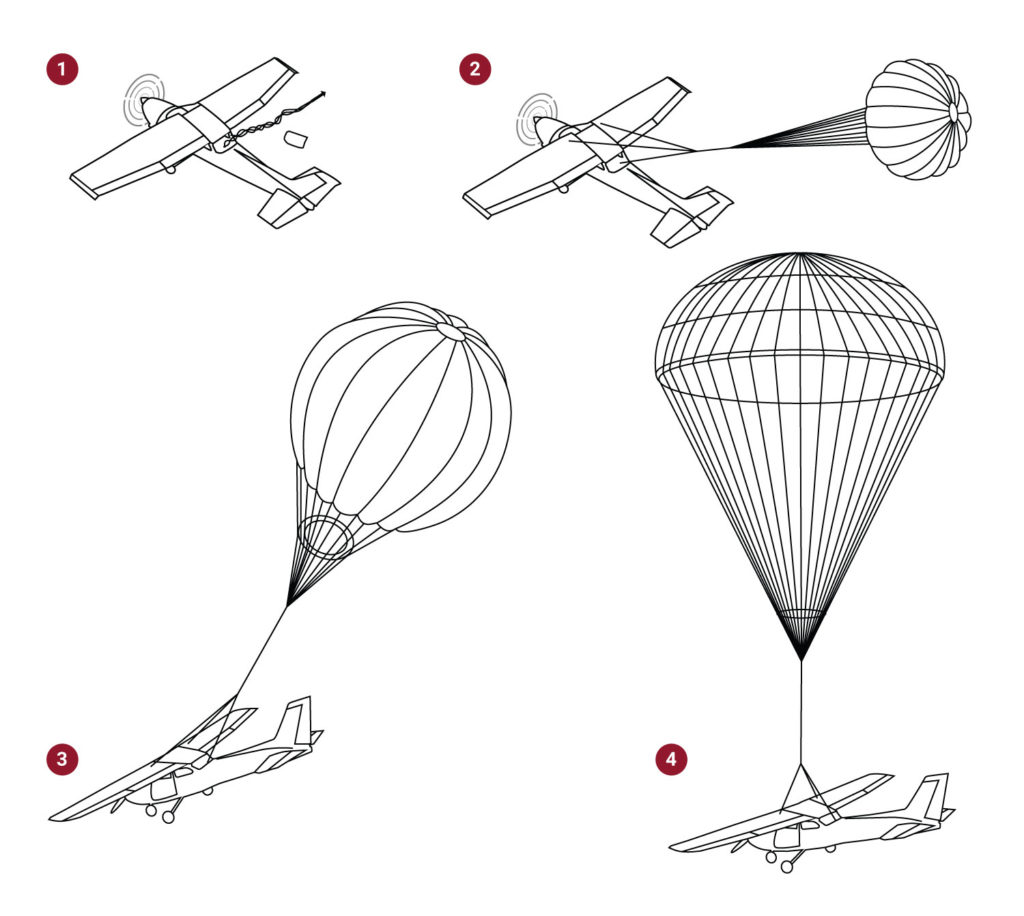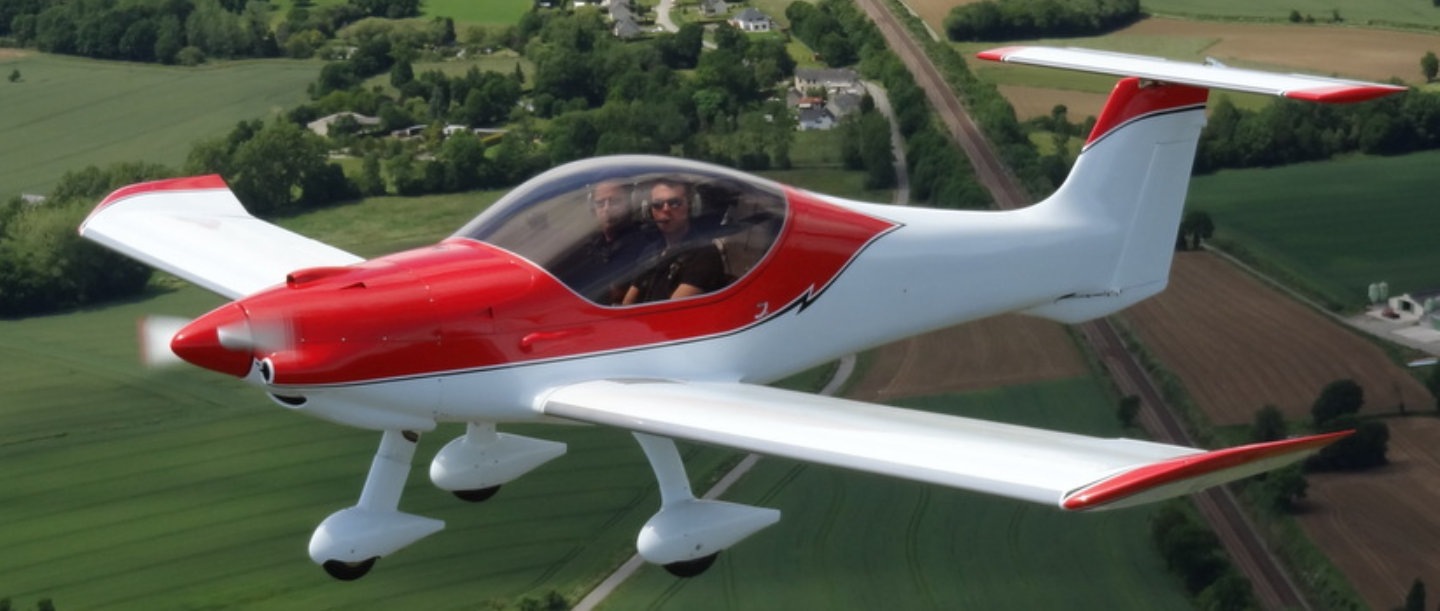Details on this particular crash are pretty thin at the moment, but we do have some information. On July 15, an ultralight aircraft was flying through Sint-Andries in Belgium when an emergency occurred, reports news site VRT NWS. At this time it’s unclear what the emergency was, but the pilot deployed a potentially lifesaving device. The plane and its pilot then came to a relatively gentle crash on a road thanks to a whole aircraft rescue parachute system. It was captured by a passerby and it’s easy to see why it’s doing rounds on the net:
Some people commenting on social media believe that the aircraft involved here is a Cirrus SR22. It’s a good guess, but there’s a different plane involved. I’ll explain why people think it’s a Cirrus. Here in the United States, whole aircraft parachute systems are known in part because of their application in Cirrus aircraft. These planes are really clever in their design. In an emergency, the pilot of a Cirrus SR20, SR22, and Vision SF50 jet can pull a red handle that activates the Cirrus Airframe Parachute System (CAPS). Here’s how it works. When the pilot pulls the handle, a rocket fires off to deploy the aircraft’s parachute. It takes about 45 pounds of force on the handle to start the rocket’s ignition process. That’s in part so that you don’t blow your ‘chute on a hard landing. Here are what the rockets look like. BRS Aerospace, a manufacturer of ballistic parachute systems and supplier for Cirrus, says its rockets accelerate over 100 mph in the first tenth of a second after ignition. And the whole firing sequence takes just a second. For Cirrus, it’s designed to bring the aircraft to a largely level descent at a rate of less than 1,700 feet per minute, or about 19 mph. BRS parachute systems are available for a variety of aircraft, including the Cessna 172 and 182. Here’s an illustration of how the parachute works with that plane: In Cirrus aircraft, the system is more than just a parachute. The airframe, seats, and landing gear are all designed to collectively absorb energy in an impact. The seats are built with a honeycomb-like structure designed to transmit as little force to the plane’s occupants as possible. Cirrus says that when CAPS is deployed, your impact should be the equivalent of being dropped from 13 feet. And in case you’re wondering, here’s an illustration on where everything is in a Cirrus SR22: The pilot reaches up and pulls on the handle. That pulls an activation cable, which leads out to behind the cabin and into a compartment housing the rocket assembly next to the parachute assembly. There are two types of ignitors. One is a percussion ignitor, which is described as: The other is an electrical ignitor, which replaces the two primers and secondary booster charge with electrical contacts. Yanking the cable closes a circuit, which initiates the firing process. When the activation cable moves the plunger approximately ½ inch, a spring compresses and two ball bearings fall free of the plunger and igniter body allowing the plunger to move rapidly opposite the direction of the activation cable, the plunger then makes contact with the firing pins, which in turn strike the primers, firing the system. The parts of the parachute system are packaged under breakaway panels. So if you walked up to a plane with a parachute system you wouldn’t know unless you saw the warning labels. And here’s what the compartment looks like: The parachute is at least 55 feet in diameter and is attached to kevlar harnesses rated for 20,000 pounds. These harnesses are also hidden behind breakaway panels that get revealed only when the system is put into operation. In the above photo, you’re seeing the rocket motor and the parachute tucked away in the compartment. The bag is roughly two feet by one foot by eight inches. The aircraft involved in this incident is much smaller, lighter, and uses its BRS-supplied parachute differently than the Cirrus planes do. This adorable plane is called a Dyn’Aéro MCR01. It’s a plane that flies in Europe’s Ultralight category. Whereas an American Ultralight cannot have an empty weight of greater than 254 pounds, a European Ultralight can be up to 1,041 pounds when it’s a two-seater with a parachute. What classifies as an Ultralight in Europe is somewhat closer to what the FAA defines as a Light Sport Aircraft. The Dyn’Aéro MCR01 sits right at the legal limit in its specs. Before I get to the parachute, let’s talk about why this French plane is so neat. It’s all-composite — built out of carbon fiber — and can hit a top speed of 198 mph with a 100 HP Rotax 912ULS flat four. The plane is a development of the MC-100 Ban-Bi, designed in the 1990s by French engineer Michel Colomban. Dyn’Aéro offered the MCR01 as a kit or ready-to-fly built in its factory. In 2018, SE Aviation acquired the rights to the aircraft and now sells an improved version called the MCR Sportster. One of the options for the MCR01 and the MCR Sportster is a BRS ballistic parachute. Deployment is like the Cirrus system, but the attachment points are towards the rear. As a result, the plane descends at a vertical attitude. The parachute system here is supposed to reduce the MCR01’s fall to a slow 12 mph.
Specifications about the MCR01’s parachute system do not appear to be readily available, but BRS notes that the safety that you get whether you have their system in a Cessna or a Cirrus is the same. Rocket and parachute sizes may be different depending on the plane. Where the rocket and parachute are stored may also differ. For example, on a Cessna the system launches out of the rear window.
Another neat thing about these systems is that they don’t need a huge amount of altitude to work. Cirrus and BRS both say that there isn’t a minimum or maximum altitude for deployment, though, at least 580 feet is recommended before deployment in a current-generation SR22. Cirrus has seen successful CAPS deployments as low as 400 feet, and Flying Magazine reports a successful parachute deployment as low as 100 feet.
However, of course, the systems still need some room to work. There have been fatalities after pilots deployed their parachutes too close to terrain. But for another good example of the work these systems do, thanks to CAPS: There were no fatalities when a Swearingen SA-226TC Metro II and a Cirrus SR22 collided in mid-air last year. BRS says that, as of this month, its systems have saved 463 planes.
In this case, the Dyn’Aéro MCR01’s ballistic parachute meant the plane nosed into the ground, but the pilot was able to hop right out and walk away. They reportedly ended up with minor injuries, and the plane’s nose is smashed up, but again, that’s way better than how some plane crashes go. This crash makes a great case for getting a plane with a whole aircraft parachute, if you can afford it.
But the biggest positive about Cirrus / their planes , is that they have constantly been improving them. Airframe, avionics, general features and power plant. Their planes of today are so much more improved than the original. Something missing in general aviation. Yes, they are more expensive. But people are finding value in the expense.
Maybe all because of the parachute. But the planes are much more.
Then they noticed the spouses, who were often quietly standing back from the plane. That is where they found out that features such as automotive-style door latches and interiors, butterfly doors, and side sticks were good marketing choices. More importantly, if given the option, pilots would leave the parachute off the options list to save weight. By making the parachute a standard feature, spouses were greenlighting purchases with much less resistance.
There might be a lesson in automotive marketing there, but I’m not sure.
I am so glad that you briefly mentioned the Cirrus and the Metroliner mid-air collision. Truly a miracle that they survived something like that. The Cessna and Piper that collided over the weekend in Vegas were not so lucky.
I went flying in a Cirrus and we had an engineer in the back that told us that his cousin had one and pulled the chute. He iced up over the Rocky Mountains and his aircraft was becoming a rock faster than an aircraft and he pulled the chute. At 0800, he had crashed into the mountains, and by 1030, he was buying his rescuers steaks. He had totaled his plane, but not himself, so he went out and bought Cirrus’s fancy new V-Jet.
- The pilots were low, as you mention, because they were both on their landing approach.
- Yes, at the time the runways were being controlled be different controllers. This is standard at Centennial in VFR conditions when there is a lot of traffic.
- The meteorological conditions were clear, so there was no staggering of the approaches necessary ((Staggering approaches is only required when you have parallel runways with narrow spacing, when operating simultaneous instrument approaches) the airplanes had responsibility to see and avoid, and the Cirrus pilot did say the traffic was in sight. (Wether he was referring to the Cessna ahead of him AND/OR the Metro, or just the Cessna would be conjecture, but both airplanes were called out by tower and he did say traffic in sight.)
- The NTSB as issued a preliminary report. https://data.ntsb.gov/carol-repgen/api/Aviation/ReportMain/GenerateNewestReport/103073/pdf The final report has not yet been published. It will be eventually.
- Why was the traffic so close together? The runways at Centennial are only 700ft apart. And the Cirrus overshot the turn by a lot… enough to collide with the other aircraft. The Metro was aligned on his runway final for the previous 2ish miles before the collision. Parallel landing operations are common at Centennial.
- Why so low? Most airports have the runways on the ground, and if the aircraft never descend down to the runway during approach landing, they never actually would land, would they? As in Ms. Streeter’s excellent original article on the incident, here is the link to the Radar track and ACT communication video from VASAviation – https://youtu.be/f5tb2dVWJqc IMO, these are of very, very marginal benefit. In most emergencies, you are better off flying/gliding the plane to an airport/field/road/somewhere; once you pull the handle, you’ve lost all of your ability to influence the direction of the aircraft. The vast majority of emergencies still leave the pilot with some control of the aircraft, and some control is better than none. The most frequent use case where this would be helpful is a mid-air collision with enough altitude to do something about it, which is an incredibly rare event. Also, consider that if you have a mid-air collision, you are probably already dead. When you factor in the extra weight of the system (reducing your useful load) and the cost of repacking the parachute every 10 years, it doesn’t make much sense for the vast majority of use cases. I mean, this guy got a plane down in the middle of a curve! https://www.theautopian.com/this-new-pilots-incredible-highway-landing-is-a-perfect-lesson-in-handling-emergencies/ That said, I’m sure that those who got to live because of a parachute would probably disagree about them being a marginal benefit. Even though instances of losing total control are rare, they do happen. I’ll never be rich enough to afford a system like this (heck, I rent an old 172), but kudos to those who can.






